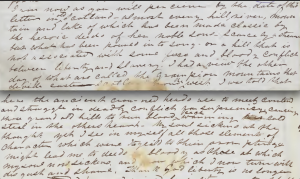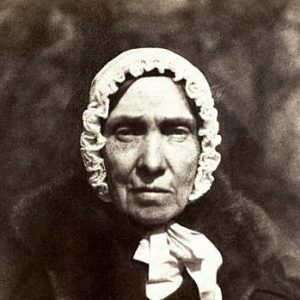Douglass finds in Scottish history an expression of the freedom that he is denied in the United States. Douglass takes his name from the hero of The Lady of the Lake – not the only namesake to feature in Scott’s work. Douglass visits the birthplace of Scotland’s most famous poet and meets a surviving relative.
The Free Hills of Old Scotland
Like many anti-slavery activists, Douglass often made much of the contrast between Britain and the United States. Britain, a monarchy, had abolished slavery in its colonies in 1833, while in the United States, a republic, the ‘peculiar institution’ continued to thrive in the South. But even in the North, where slavery had all but fizzled out by the third decade of the century, Douglass found himself
doomed by an inveterate prejudice against color to insult and outrage on every hand … – denied the privileges and courtesies common to others in the use of the most humble means of conveyance – shut out from the cabins on steamboats – refused admission to respectable hotels – caricatured, scorned, scoffed, mocked, and maltreated, with impunity by any one, (no matter how black his heart,) so he has a white skin.
But once on the other side of the Atlantic, ‘behold the change!’ In a speech given on the eve of his return to the United States, he recalled
I have travelled in all parts of the country: in England, Ireland, Scotland, and Wales. I have journeyed upon highways, byways, railways and steamboats. I have myself gone, I might say, with almost electric speed; but at all events my trunk has been overttaken by electric speed. In none of these various conveyances, or in any class of society, have I found any curled lip of scorn, or an expression that I could torture into a word of disresepct of me on account of my complexion; not once…
However, he does seem to have had a special place in his heart for Scotland. In Dundee on 29 January 1846 he wrote:
I am now as you will perceive by the date of this letter in Scotland, almost every hill, river, mountain and lake of which has been made classic by the heroic deeds of her noble sons. Scarcely a stream but has been poured into song, or a hill that is not associated with some fierce and bloody conflict between liberty and slavery.

And, addressing himself to an American who had dared question the authenticity of his Narrative, he invoked a Scottish hero:
You must not judge me by what I then was – a change of circumstances has made a surprising change in me. Frederick Douglass, the freeman, is a very different person from Frederick Bailey, (my former name), the slave. I feel myself almost a new man – freedom has given me a new life. I fancy you would scarcely know me. i think I have altered very much in my general appearance, and know I have in my manners. you remember when I used to meet you on the road to St Michaels, or near Mr Covey’s lane gate, I hardly dared to lift my head, and lok up at you. If I should meet you now, aimd the free hills of old Scotland, where the ancient ‘black Douglass’ once met his foes, I presume I might summon sufficient fortitude to look you full in the face; and were you to attempt to make a slave of me, it is possible you might find me almost as disagreeable a subject, as was the Douglass to whom I have just referred. Of one thing, I am certain – you would see a great change in me!
Sir Walter Scott
It wasn’t quite a coincidence that Douglass shares the same name as ‘the ancient “black Douglass”‘. Born Frederick Augustus Washington Bailey, he dispensed with his two middle names early in life. When he escaped from Baltimore, he adopted several other names, including Stanley, designed to thrown any pursuers off the track, and arrived in New Bedford, Massachusetts, as Johnson. But, as he explains in his autobiographies, the name Johnson was very common in that town, and was even the name of the family who took him in. His host,
unwilling to have another of his own name added to the community in this unauthorised way, after I spent a night and a day at his house, gave me my present name. He had been reading Lady of the Lake, and was pleased to regard me as a suitable person to wear this, one of Scotland’s many famous names.
No doubt the choice was an appropriate one. Even if the fugitive slave was not yet acquainted with Walter Scott‘s famous poem, he certainly became so, and his library at Cedar Hill in Washington, DC – still preserved – boasts several editions of the collected works. The hero is – like Douglass – an outlaw and member of an ‘exiled race’. And at one point Scott compares him to a ‘hunted stag’, recalling the famous hunting scene at the beginning and in which, significantly, the ‘antler’d monarch’ gets away. Perhaps this caught the notice of the man who a few years’ later would recount his escape from ‘the hunters of men.’
Scott was hugely popular in the United States. Readers there became acquainted with Scottish history not only through his poems and novels but his non-fiction works such as Tales of a Grandfather. Many of those who travelled to Britain were inspired to visit some of the places he had so romantically described, such as the Trossachs, which served as the setting for The Lady of the Lake. Among them were some of Douglass’ fellow abolitionists who toured Scotland after attending the World Anti-Slavery Convention in London in 1840. And Henry Clarke Wright – with whom Douglass would join forces in Perth in January 1846 – had already, for over a year, been writing lyrically about the scenery Scott made famous, in letters to the Liberator.
So even if he had little time to read Scott as an overstretched antislavery campaigner in New England and beyond – he was almost permanently on tour from early 1842 until late 1844 – he would surely have absorbed some of these stories before he crossed the Atlantic. Once he was in Scotland, his name would have given his hosts an excuse to offer more re-tellings had they needed one.
The original ‘Black Douglas’ referred to in the letter above was the Good Sir James Douglas, the king’s leading military commander, and knighted by Robert Bruce on the eve of Bannockburn (1314), given the nickname by his English enemies, for his dark hair and complexion, and his diabolical reputation on the battlefield. He features in Scott’s last novel, Castle Dangerous (1832). But the whole line of Sir James’ successors were known as the Black Douglases, including Archibald the Grim (or ‘Blak’ Archibald), the third Earl of Douglas, who appears in The Fair Maid of Perth (1828).
The Black Douglases must be distinguished from the Earls of Angus, who became known as the Red Douglases, of whom it was Archibald Douglas, Sixth Earl who threatened James V and indeed imprisoned him in 1525. James escaped and managed to win back his authority, and subsequently passed sentence of forfeiture against Douglas and his kinsmen. Scott identified the protagonist of The Lady of the Lake as Archibald’s nephew James Douglas, also known as the fourth Earl of Morton who, during the period of his family’s banishment, lived in the north of Scotland under an assumed name.
Even a superficial understanding of these aristocratic families would have been enough for Douglass to eagerly exploit the resonance of his adopted Scottish name that could signify both his status as an outlaw and a hunted fugitive on the one hand, and his dream of leading his oppressed compatriots to victory of their enemies on the other.
Robert Burns
There is no record of Douglass having visited Abbotsford when he was in Scotland – although the home of Walter Scott (who died a just over a decade earlier) was a favourite destination of literary pilgrims from the Europe and the United States at the time.

In a letter, later printed in the New York Tribune, Douglass wrote animatedly of the romantic setting of his monument. He took delight in being able to see with his own eyes the places named in ‘Tam o’ Shanter’ and ‘Ye Banks and Braes’. And he was honoured to meet Burns’ 80-year old sister, Isabella Burns Begg, ‘a spirited looking woman who bids fair to live yet many days.’
The letter went on to pay a generous tribute to the man – whose past trials and tribulations somewhat resembled his own:
I have ever esteemed Robert Burns a true soul but never could I have had the high opinion of the man or his genius, which I now entertain, without my present knowledge of the country, to which he belonged – the times in which he lived, and the broad Scotch tongue in which he wrote. Burns lived in the midst of a bigoted and besotted clergy – a pious, but corrupt generation – a proud, ambitious, and contemptuous aristocracy, who, esteemed a little more than a man, and looked upon the plowman, such as was the noble Burns, as being little better than a brute. He became disgusted with the pious frauds, indignant at the bigotry, filled with contempt for the hollow pretensions set up by the shallow-brained aristocracy. He broke loose from the moorings which society had thrown around him. Spurning all restraint, he sought a path for his feet, and, like all bold pioneers, he made crooked paths. We may lament it, we may weep over it, but in the lagnauge of another, we shall lament and weep with him. The elements of character which urge him on are in us all, and influencing our conduct every day of our lives. We may pity him, but we can’t despise him. We may condemn his faults, but only as we condemn our own. His very weakness was an index of his strength. Full of faults of a grievous nature, yet far more faultless than many who have come down to us in the pages of history as saints.
In Rochester, New York, nearly two years after his return from Britain in April 1847, Douglass was invited to address a Burns Supper. He reflected on his travels in Scotland, his meeting with the poet’s sister, and clearly could have gone on at length.
But, ladies and gentlemen, this is not a time for long speeches. I do not wish to detain you from the social pleasures that await you. I repeat again, that though I am not a Scotchman, and have a colored skin, I am proud to be among you this evening. And if any think me out of my place on this occasion (pointing at the picture of Burns), I beg that the blame may be laid at the door of him who taught me that ‘a man’s a man for a’ that.’